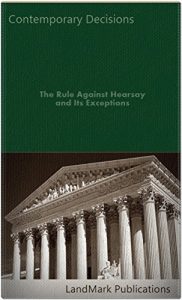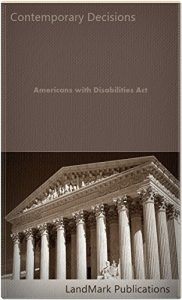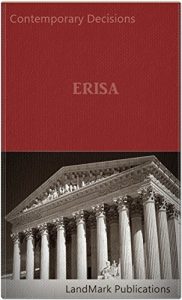THIS CASEBOOK contains a selection of 195 U. S. Court of Appeals decisions that analyze, interpret and discuss the rule against hearsay and its exceptions. The selection of decisions spans from 2005 to the date of publication.
A proponent of hearsay evidence must establish five elements in order to satisfy Rule 807: "(1) circumstantial guarantees of trustworthiness; (2) materiality; (3) probative value; (4) the interests of justice; and (5) notice." United States v. Ochoa, 229 F.3d 631, 638 (7th Cir. 2000) (citing United States v. Hall, 165 F.3d 1095, 1110 (7th Cir. 1999)). US v. Moore, (7th Cir. 2016).
Rule 807 provides that a hearsay statement is not excluded by the rule against hearsay, even if not covered by an exception in Rule 803 or 804, if the statement (1) has "equivalent circumstantial guarantees of trustworthiness" to statements admitted under the enumerated exceptions, (2) is offered as evidence of a material fact, (3) is more probative on the point offered than any other reasonably available evidence, and (4) will best serve the general purposes of the rules of evidence and the interests of justice. We have said that this exception to the rule against hearsay "was necessary to permit courts to admit evidence in exceptional circumstances where the evidence was necessary, highly probative, and carried a guarantee of trustworthiness equivalent to or superior to that which underlies the other recognized exceptions." United States v. Renville, 779 F.2d 430, 439 (8th Cir. 1985). US v. Stoney End of Horn, (8th Cir. 2016).
* * *
"[P]rior inconsistent statements by a witness are not hearsay and are competent as substantive evidence if the declarant testifies at trial and is subject to cross-examination concerning the statement, and the prior inconsistent statement was given under oath at a 'trial, hearing, or other proceeding.'" United States v. Wilson, 806 F.2d 171, 175-76 (8th Cir. 1986) (quoting Fed. R. Evid. 801(d)(1)(A)). "The district court has considerable discretion in determining whether prior statements are inconsistent with trial testimony." United States v. Matlock, 109 F.3d 1313, 1319 (8th Cir. 1997) (citing United States v. Russell, 712 F.2d 1256, 1258 (8th Cir. 1983) (per curiam); United States v. Thompson, 708 F.2d 1294, 1302 (8th Cir. 1983) ("The district court should have considerable discretion to determine whether evasive answers are inconsistent with statements previously given." (citation omitted))). US v. Dean, (8th Cir. 2016).
* * *
Federal Rule of Evidence 801 provides that a statement offered against a party is not hearsay if the statement was "made by the party's coconspirator during and in furtherance of the conspiracy." Fed. R. Evid. 801(d)(2)(E). Statements can further the conspiracy in a number of ways. "Some examples include comments designed to assist in recruiting potential members, to inform other members about the progress of the conspiracy, to control damage to or detection of the conspiracy, to hide the criminal objectives of the conspiracy, or to instill confidence and prevent the desertion of other members." Johnson, 200 F.3d at 533. A coconspirator's statement may satisfy the "in furtherance" requirement even if the statement was not "exclusively, or even primarily, made to further the conspiracy." United States v. Cruz-Rea, 626 F.3d 929, 937 (7th Cir. 2010). US v. Elder, (7th Cir. 2016).
A proponent of hearsay evidence must establish five elements in order to satisfy Rule 807: "(1) circumstantial guarantees of trustworthiness; (2) materiality; (3) probative value; (4) the interests of justice; and (5) notice." United States v. Ochoa, 229 F.3d 631, 638 (7th Cir. 2000) (citing United States v. Hall, 165 F.3d 1095, 1110 (7th Cir. 1999)). US v. Moore, (7th Cir. 2016).
Rule 807 provides that a hearsay statement is not excluded by the rule against hearsay, even if not covered by an exception in Rule 803 or 804, if the statement (1) has "equivalent circumstantial guarantees of trustworthiness" to statements admitted under the enumerated exceptions, (2) is offered as evidence of a material fact, (3) is more probative on the point offered than any other reasonably available evidence, and (4) will best serve the general purposes of the rules of evidence and the interests of justice. We have said that this exception to the rule against hearsay "was necessary to permit courts to admit evidence in exceptional circumstances where the evidence was necessary, highly probative, and carried a guarantee of trustworthiness equivalent to or superior to that which underlies the other recognized exceptions." United States v. Renville, 779 F.2d 430, 439 (8th Cir. 1985). US v. Stoney End of Horn, (8th Cir. 2016).
* * *
"[P]rior inconsistent statements by a witness are not hearsay and are competent as substantive evidence if the declarant testifies at trial and is subject to cross-examination concerning the statement, and the prior inconsistent statement was given under oath at a 'trial, hearing, or other proceeding.'" United States v. Wilson, 806 F.2d 171, 175-76 (8th Cir. 1986) (quoting Fed. R. Evid. 801(d)(1)(A)). "The district court has considerable discretion in determining whether prior statements are inconsistent with trial testimony." United States v. Matlock, 109 F.3d 1313, 1319 (8th Cir. 1997) (citing United States v. Russell, 712 F.2d 1256, 1258 (8th Cir. 1983) (per curiam); United States v. Thompson, 708 F.2d 1294, 1302 (8th Cir. 1983) ("The district court should have considerable discretion to determine whether evasive answers are inconsistent with statements previously given." (citation omitted))). US v. Dean, (8th Cir. 2016).
* * *
Federal Rule of Evidence 801 provides that a statement offered against a party is not hearsay if the statement was "made by the party's coconspirator during and in furtherance of the conspiracy." Fed. R. Evid. 801(d)(2)(E). Statements can further the conspiracy in a number of ways. "Some examples include comments designed to assist in recruiting potential members, to inform other members about the progress of the conspiracy, to control damage to or detection of the conspiracy, to hide the criminal objectives of the conspiracy, or to instill confidence and prevent the desertion of other members." Johnson, 200 F.3d at 533. A coconspirator's statement may satisfy the "in furtherance" requirement even if the statement was not "exclusively, or even primarily, made to further the conspiracy." United States v. Cruz-Rea, 626 F.3d 929, 937 (7th Cir. 2010). US v. Elder, (7th Cir. 2016).












